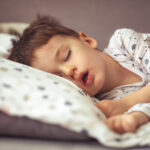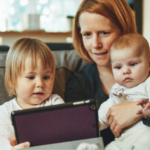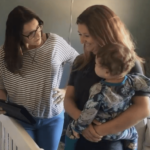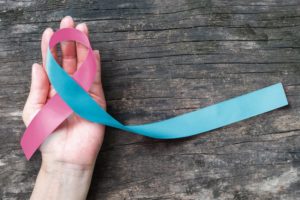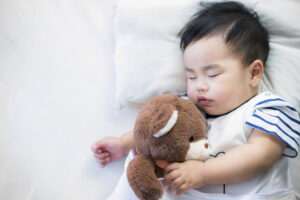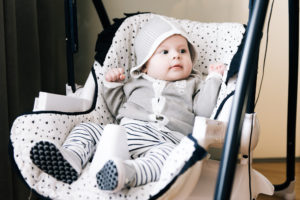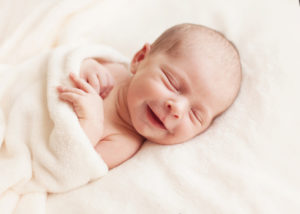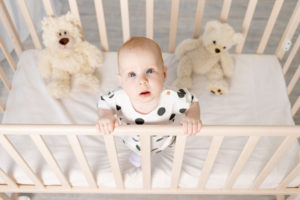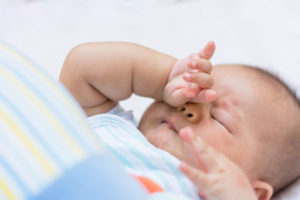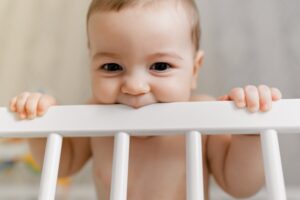When you buy through our links, we may earn a commission. Products or services may be offered by an affiliated entity. Learn more.
Co-Sleeping
As a new parent or caregiver, there can be a lot to learn about infant sleep. Common questions involve how long babies should sleep and when they are capable of sleeping through the night. Many caregivers also have questions about sleep safety for infants and how to reduce the risk of nighttime accidents and injuries.
Parents may encounter inconsistent messaging about co-sleeping and the best sleep practices for infants, especially on social media platforms and through advertisements. Safe sleep guidelines have been developed by agencies in children’s best interests.
However, to learn more about keeping an infant safe during sleep, caregivers should work with their infant’s pediatrician. It can also help to understand the risks and benefits of co-sleeping and to consider safety tips for people who choose to co-sleep with their infant.
What Is Co-Sleeping?
Not everyone uses the term co-sleeping in the same way. Depending on the source, co-sleeping may be used to refer to several different sleep practices .
- Bed-sharing: Bed-sharing is the practice of the infant and caregiver sleeping in the same bed. This may also be called surface sharing because it includes when a caregiver and infant sleep together on a couch, chair, or the floor.
- Room-sharing: Room-sharing is when an infant sleeps on a separate surface but in the same room as the caregiver.
- Rooming-in: Rooming-in is a type of room-sharing that occurs in the hospital immediately after an infant is born. This involves keeping the infant on their own sleeping surface close to their parent for up to 24 hours a day while still in the hospital.
Help Your Baby Sleep Better With Pediatric Sleep Coaching
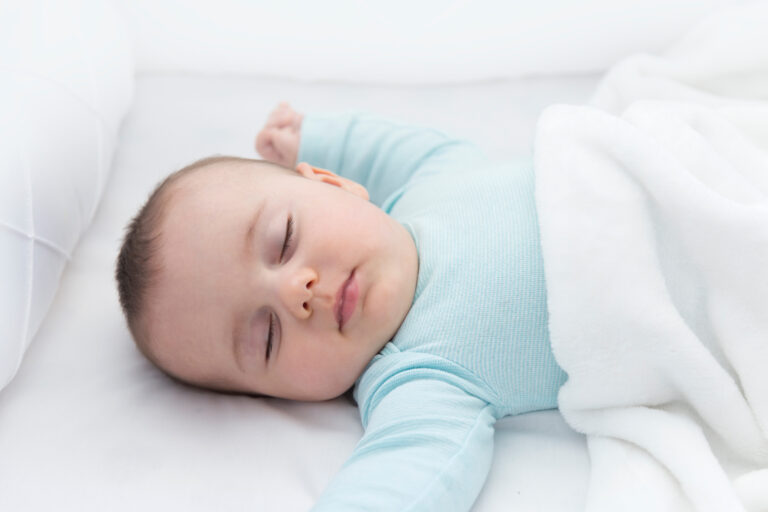
our partner at sleepdoctor.com
Learn More“Life-changing! My anxiety about my son’s sleeping habits were immediately reduced after talking to Sara. She went above and beyond to tailor a schedule to our goals, answer our questions, keep us on track, and check in to encourage us when we just thought we couldn’t do it anymore.”
Rachael B. – Verified Customer
Is it Safe to Co-Sleep With A Baby?
The American Academy of Pediatrics strongly recommends room-sharing but discourages bed-sharing. Some types of co-sleeping may pose risks for an infant’s health.
Although these experts do not recommend bed-sharing, they acknowledge that many caregivers still choose to sleep on the same surface as an infant. Like other infant care practices, whether caregivers choose to bed-share is influenced by cultural and other factors.
From the early 20th century until recently, cultural norms in the United States emphasized the benefits of formula, bottle feeding, and transitioning infants to sleep in separate rooms. These norms have started to shift as increased breastfeeding and forms of co-sleeping are becoming more common . As many as 60% of infants less than 1 year old now bed-share with a caregiver either occasionally or on a regular basis.
In many other cultures throughout the world, different types of co-sleeping have long been viewed positively . Some studies have found that certain countries where bed-sharing is common also have low rates of sudden infant death . However, it is not clear if these lower rates are driven by bed-sharing or by other practices in these countries that promote infant health, such as higher rates of breastfeeding, lower levels of smoking during pregnancy, and easier access to medical care. Additionally, in these countries where bed-sharing is common, the infant may be on a firm, flat sleeping surface without excessive bedding.
Bed-Sharing
Experts in the United States warn caregivers against bed-sharing with infants due to the increased risk of accidents and injuries . These experts point to an elevated risk of sudden unexpected infant death (SUID) and sudden infant death syndrome (SIDS) in infants who share a sleeping surface with their caregiver.
Sudden unexpected infant death refers to the unanticipated death of an infant during their first year of life. Examples of causes of SUID include injury, heart problems, infection, choking, and suffocation. An infant who dies suddenly is described as experiencing SIDS if no specific explanation can be found for their death.
Older research suggested a potential benefit of bed-sharing in that it could increase the duration of breastfeeding . However, the most recent expert recommendations are clear that even if breastfeeding happens in bed, the infant should be returned to a separate location for sleep.
Room-Sharing
Placing an infant on their own sleeping surface but within reach of their caregiver is recommended by experts in infant health. Benefits of room-sharing include increased access to an infant and a lower risk of SIDS and other causes of infant death.
- Easier to check on an infant: Sleeping within view and reach of the infant’s separate sleeping space allows caregivers to check on and comfort their baby without leaving the bed.
- Reduces risk of SIDS: Infants are at a decreased risk of injury and accidents when they are placed on a separate sleeping surface. In fact, room-sharing may reduce the risk of SIDS by up to 50% . Room-sharing is also safer than having an infant sleep in a separate room.
While many experts recommend room-sharing, there are potential downsides to this practice.
- Less breastfeeding: Early research suggests that room-sharing may be associated with a shorter period of breastfeeding compared to bed-sharing. If there is a decrease in the frequency of breastfeeding, it may lead to a reduction in a caregiver’s production of breastmilk .
- Accidental bed-sharing: Even people who want to avoid bed-sharing may unintentionally fall asleep while breastfeeding, which may create an unsafe sleeping situation for their infant.
Rooming-In
Rooming-in occurs in the hospital right after birth and involves keeping an infant very close to their parent but on a separate sleeping surface. Rooming-in is recommended by organizations such as the American Academy of Pediatrics and the World Health Organization as an important part of postnatal care. Rooming-in promotes skin-to-skin contact, improves breastfeeding, and develops a healthy bond between caregiver and child.
While rooming-in is typically recommended, it can be associated with certain risks. Experts suggest taking precautions when rooming-in to reduce the risk of accidents and injury.
- Being cautious about falling asleep: Birth parents commonly fall asleep while providing skin-to-skin contact after giving birth. Because this can create a dangerous situation for newborns, nurses and other support staff should be available to help move an infant back to their sleeping area if needed.
- Avoiding bed-sharing: Bed-sharing is dangerous for infants under 1 year old. While rooming-in, parents should always place a newborn on their back on a separate surface such as a bassinet or side-car crib.
- Asking for support: Caregivers should feel comfortable asking for help from professionals like doctors, nurses, nursing assistants, and health educators, who are able to discuss infant sleep practices and help move an infant to an appropriate sleep surface if the caregiver needs assistance.
When Is Co-Sleeping More Dangerous?
Co-sleeping, especially bed-sharing, can pose greater danger to infant health in specific situations. Research has shown that certain factors can raise the risks caused by bed-sharing, and caregivers should avoid bed-sharing in these circumstances.
- Preterm infants: Bed-sharing is particularly risky for infants who were born prior to 37 weeks of pregnancy. Infants of low birth weight are also more vulnerable to SIDS and accidental injury from bed-sharing.
- Impaired caregivers: There is a heightened risk of injury for infants sharing a sleeping surface with someone who is experiencing fatigue or who is impaired by the use of medications, alcohol, or other substances.
- Bed-sharing with someone other than the parent: Sleeping with anyone other than the infant’s parent, including other caregivers or children, can increase the danger of bed-sharing and is not recommended.
- Soft bedding, surfaces, or accessories: Plush bedding, pillows, and other sleep accessories heighten the risks of an infant suffocating or getting too hot and should not be used in an infant’s sleep area. Caregivers should also avoid sleeping with infants on sofas, armchairs, and waterbeds.
- Tobacco use: Bed-sharing with a smoker increases the risk of SIDS. The risk of infant death is also elevated if the infant’s parent smoked while pregnant.
Tips and Precautions for Safer Co-Sleeping
Taking precautions can help reduce risks to infant safety while co-sleeping. Regardless of the exact sleeping arrangement, several tips can help make the sleep environment safe and comfortable for an infant.
- Avoid soft surfaces: Infants are safest when sleeping on firm and flat surfaces that are designed for infant sleep. Sleeping surfaces that are soft, like couches, memory foam beds, and air mattresses, can cause difficulty breathing and increase the risk of accidents.
- Clear the sleeping area: Caregivers should clear the infant’s sleeping area of anything loose or soft, including pillows, toys, blankets, stuffed animals, and crib bumpers. They should also eliminate the use of positioners and other products that claim to reduce the risk of SIDS as many of these can actually increase the risk of injury and SUID.
- Place a baby on their back: Babies should always be placed on their back when sleeping, even during daytime naps. This sleep position is associated with a lower risk of SIDS as well as reduced risks of fevers, nasal congestion, and ear infections.
- Keep pets and other children off the bed: Bed-sharing with more than one caregiver, other children, or pets increases the risk of SIDS .
- Prevent overheating: Keep an infant safe by making sure their face and head are uncovered during sleep and by dressing them in sleeping clothes or a wearable blanket . Avoid overlayering or using blankets to keep an infant warm. Caregivers can monitor a sleeping infant’s temperature by feeling the infant’s chest and checking for sweating.
- Offer a pacifier: Research suggests that offering an infant a pacifier for naps and at bedtime may reduce the risk of SIDS .
Perhaps the most important part of safe co-sleeping is being open and honest with an infant’s pediatrician. Although parents and caregivers may feel reluctant to tell their pediatrician about bed-sharing, medical professionals generally understand that many caregivers choose to sleep with their infant. Having an open and honest conversation with a pediatrician can help caregivers learn about the safest method of co-sleeping based on their family’s lifestyle, culture, and beliefs.
Transitioning Away From Co-Sleeping
There is no consensus on when a baby should stop co-sleeping and start sleeping in their own room. The American Academy of Pediatrics recommends room-sharing for at least the first 6 months, which is when the risk of injury or death during sleep is highest.
Parents and caregivers can consult with a baby’s pediatrician about when is the right time for their child to start sleeping in a separate room. The pediatrician may also offer suggestions for how to facilitate a smooth transition away from room-sharing.
When setting up a baby in their own room, it is important to continue to follow precautions for safe sleep. Creating a comfortable sleeping environment while following consistent bedtime routines may help a baby know what to expect and acclimate to change with less disruption to their sleep.

Still have questions? Ask our community!
Join our Sleep Care Community — a trusted hub of sleep health professionals, product specialists, and people just like you. Whether you need expert sleep advice for your insomnia or you’re searching for the perfect mattress, we’ve got you covered. Get personalized guidance from the experts who know sleep best.
References
20 Sources
-
National Institute of Child Health and Human Development. (n.d.). Frequently asked questions (FAQs) about SIDS and safe infant sleep.
https://safetosleep.nichd.nih.gov/safesleepbasics/faq -
Corwin, M.J.. (2021, December 14). Sudden infant death syndrome: Risk factors and risk reduction strategies. In G. B. Mallory, S.M. Misra (Eds.). UpToDate.
https://www.uptodate.com/contents/sudden-infant-death-syndrome-risk-factors-and-risk-reduction-strategies -
Moon, R. Y., Carlin, R. F., Hand, I., & Task Force on Sudden Infant Death Syndrome and the Committee on Fetus and Newborn (2022). Sleep-related infant deaths: Updated 2022 recommendations for reducing infant deaths in the sleep environment. Pediatrics, 150(1), e2022057990., Updated 2022 recommendations for reducing infant deaths in the sleep environment. Pediatrics, 150(1), e2022057990.
https://pubmed.ncbi.nlm.nih.gov/35726558/ -
National Center for Chronic Disease Prevention and Health Promotion, Division of Nutrition, Physical Activity, and Obesity. (2020, January 5). Infant safety in maternity care practices that support breastfeeding in US birth facilities. Centers for Disease Control and Prevention. Retrieved August 20, 2022, from, Retrieved August 20, 2022, from
https://www.cdc.gov/breastfeeding/php/guidelines-recommendations/safety-in-maternity-care.html -
Blair, P. S., Ball, H. L., McKenna, J. J., Feldman-Winter, L., Marinelli, K. A., Bartick, M. C., & Academy of Breastfeeding Medicine (2020). Bedsharing and breastfeeding: The Academy of Breastfeeding Medicine protocol #6. Breastfeeding Medicine, 15(1), 5–16.
https://pubmed.ncbi.nlm.nih.gov/31898916/ -
Gettler, L. T., Kuo, P. X., Sarma, M. S., Lefever, J., Cummings, E. M., McKenna, J. J., & Braungart-Rieker, J. M. (2021). US fathers’ reports of bonding, infant temperament and psychosocial stress based on family sleep arrangements. Evolution, Medicine, and Public Health, 9(1), 460–469.
https://pubmed.ncbi.nlm.nih.gov/35154780/ -
Moon, R. Y., Mathews, A., Joyner, B. L., Oden, R. P., He, J., & McCarter, R., Jr (2017). Impact of a randomized controlled trial to reduce bedsharing on breastfeeding rates and duration for African-American infants. Journal of Community Health, 42(4), 707–715.
https://pubmed.ncbi.nlm.nih.gov/28064421/ -
Das, R. R., Sankar, M. J., & Agarwal, R. (2021). Bed sharing versus no bed sharing for healthy term neonates. The Cochrane Database of Systematic Reviews, 4(4), CD012866.
https://pubmed.ncbi.nlm.nih.gov/33831222/ -
Bartick, M., & Tomori, C. (2019). Sudden infant death and social justice: A syndemics approach. Maternal & Child Nutrition, 15(1), e12652.
https://pubmed.ncbi.nlm.nih.gov/30136404/ -
National Institute of Child Health and Human Development. (n.d.). Common SIDS and SUID terms and definitions. Retrieved August 20, 2022, from, Retrieved August 20, 2022, from
https://safetosleep.nichd.nih.gov/safesleepbasics/SIDS/Common -
Gettler, L. T., & McKenna, J. J. (2011). Evolutionary perspectives on mother-infant sleep proximity and breastfeeding in a laboratory setting. American Journal of Physical Anthropology, 144(3), 454–462.
https://pubmed.ncbi.nlm.nih.gov/21302271/ -
Eunice Kennedy Shriver National Institute of Child Health and Human Development (NICHD). (n.d.). Ways to Reduce The Risk Of SIDS And Other Sleep-Related Causes Of Infant Death.
https://safetosleep.nichd.nih.gov/safesleepbasics/risk/reduce -
National Center for Chronic Disease Prevention and Health Promotion, Division of Reproductive Health. (2021, September 27). Helping babies sleep safely. Centers for Disease Control and Prevention.
https://www.cdc.gov/reproductivehealth/features/baby-safe-sleep/index.html -
Office on Women's Health. (2021, February 22). Making breastmilk. U.S. Department of Health and Human Services. Retrieved August 20, 2022, from, Retrieved August 20, 2022, from
https://www.womenshealth.gov/breastfeeding/learning-breastfeed/making-breastmilk -
Feldman-Winter, L., Goldsmith, J. P., Committee on Fetus and Newborn, & Task Force on Sudden Infant Death Syndrome (2016). Safe sleep and skin-to-skin care in the neonatal period for healthy term newborns. Pediatrics, 138(3), e20161889.
https://pubmed.ncbi.nlm.nih.gov/27550975/ -
National Institute of Child Health and Human Development. (n.d.). Myths and facts about SIDS and safe infant sleep. Retrieved August 20, 2022, from, Retrieved August 20, 2022, from
https://safetosleep.nichd.nih.gov/safesleepbasics/mythsfacts -
National Institute of Child Health and Human Development. (n.d.). Known risk factors for SIDS and other sleep-related causes of infant death.
https://safetosleep.nichd.nih.gov/safesleepbasics/risk/factors -
National Institute of Child Health and Human Development. (2019, January). Safe sleep for your baby. Retrieved August 20, 2022, from, Retrieved August 20, 2022, from
https://www.nichd.nih.gov/sites/default/files/2019-04/Safe_to_Sleep_AI_AN_brochure.pdf -
Division of Reproductive Health, National Center for Chronic Disease Prevention and Health Promotion. (2019, December 9). Sudden Unexpected Infant Death and Sudden Infant Death Syndrome. Centers for Disease Control.
https://www.cdc.gov/sudden-infant-death/about/index.html -
American Academy of Pediatrics (AAP). (2011, December 6). Toddler Bedtime Trouble: Tips for Parents.
https://www.healthychildren.org/English/healthy-living/sleep/Pages/Bedtime-Trouble.aspx


